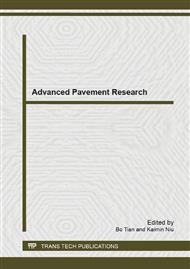[1]
F. J. Zhou, L.J. Sun Li-jun. Optimal Thickness of Asphalt Overlay on Existing Concrete Pavement. Journal of Tongji University, 29. 10 (2010) 1234-1239. (in Chinese).
Google Scholar
[2]
C.S. Hu, B.G. Wang. Composite Pavement with Asphalt Concrete Upper Layer and Cement Concrete Under-layer. China Journal of Highway and Transport. 7. 4 (1994): 33-39. (in Chinese).
Google Scholar
[3]
Bozkurt, Diyar. Three Dimensional Finite Element Analysis to Evaluate Reflective Cracking Potential in Asphalt Concrete Overlays. University of Illinois at Urbana-Champaign, (2002).
Google Scholar
[4]
Noonan, James, F.R. McCullagh. Reduction of Reflection Cracking in Bituminous Overlays on Rigid Pavements. Engineering Research and Development Bureau, New York State Department of Transportation, (1980).
Google Scholar
[5]
G. Wouter, B. Danny. Treatments for Reduction of Reflective Cracking of Asphalt Overlays on Jointed-Concrete Pavements in Georgia. Transportation Research Record, (1983) 1-6.
Google Scholar
[6]
Shatnawi, Shakir R. Procedure for evaluating reflective cracking. Proceedings of the Materials Engineering Conference, v 2, Materials for the New Millennium, 1996, pp.1429-1438.
Google Scholar
[7]
O. Antwi, B. Emmanuel, L. Khazanovich, and T.G. Leslie. Mechanistic-based model for predicting reflective cracking in asphalt concrete-overlaid pavements. Transportation Research Record: Journal of the Transportation Research Board 1629. 1 (1998).
DOI: 10.3141/1629-26
Google Scholar
[8]
Knight, E. Norman, G.L. Hoffman. Heavy Duty Membrane for the Reduction of Reflective Cracking in Bituminous Concrete Overlays. ASTM Special Technical Publication, (1985) 51-64.
DOI: 10.1520/stp32919s
Google Scholar
[9]
Kher, Ramesh. Road Test to Determine Implications of Preventing Thermal Reflection Cracking in Asphalt Overlays. Transportation Research Record, 632, (1977) 37-44.
Google Scholar
[10]
M. A. Mooty, E.H. Mohamed, J. Haddad. Fiber Optics for Evaluation of Pavement Reinforcement Materials in Resisting Reflection Cracking. Transportation Research Record, n 1536, (1996) 140-145.
DOI: 10.1177/0361198196153600121
Google Scholar
[11]
I. Ishai, M. Livneh, O. Kief, E. Altus. Experimental and Analytical Model for the Role of Reinforced Asphaltic Membranes in Retardation of Reflective Cracking. Asphalt Paving Technology: Association of Asphalt Paving Technologists-Proceedings of the Technical Sessions, 62, (1993).
Google Scholar
[12]
A.K. Gupta, S.S. Jain, G.R. Singh. Computer Applications for Design of Overlays Based on Deflection Data for Flexible Pavements. Indian Highways, 15(1), (1987) 16-21.
Google Scholar
[13]
A. Windmill. Asphalt and Coated Macadam for Airfield Pavements. Civil Engineering (London), May, (1984) 34-43.
Google Scholar
[14]
H. CAI, M.J. Zhang, S.L. Xu. Fatigue Analysis and Simulation Calculation of Reflecting Fracture. Journal of Shenyang Architectural and Civil Engineering Institute, 13. 3(1997) 252-258. (in Chinese).
Google Scholar
[15]
J.C. Wang, Y.H. Zhao. Fatigue Damage Analysis of Asphalt Pavement with Reflecting Cracks under Varying Temperature. Chinese Journal of Geotechnical Engineering, 11(2001) 669-671. (in Chinese).
Google Scholar
[16]
Z.M. Tan. Mechanistic Analysis for the Opening Reflective Cracking in Asphalt Overlays. Journal of Tongji University. 25(6), (1997) 635-639. (in Chinese).
Google Scholar
[17]
W.D. Liao, S.F. Chen, Y.Q. Liu. Research on Anti-fatigue Performance of Strata Stress Absorbing Layers. Journal of Wuhan University of Technology, 25(12), (2003) 1-4. (in Chinese).
Google Scholar
[18]
J.E. Statton, P. Kadar. Performance of Pavement Rehabilitations under Accelerated Loading. Conference of the Australian Road Research Board, Pavements and Materials, (1990) 327-345.
Google Scholar
[19]
Issam Minkarah, Rajagopal Arudi. Effectiveness of Breaking and Seating of Reinforced PCC Pavements Before Overlay. University of Cincinnati. Cincinnati Ohio. USA. July (1995).
Google Scholar
[20]
Cleveland, S. Gregory, J. W. Button, and R. L. Lytton. Geosynthetics in Flexible and Rigid Pavement Overlay Systems to Reduce Reflection Cracking. Texas Transportation Institute, Texas A & M University System, (2002).
Google Scholar
[21]
Amini, Farshad. Potential Applications of Paving Fabrics to Reduce Reflective Cracking, Jackson State University, (2005).
Google Scholar
[22]
J.W. Button, R.L. Lytton. Guidelines for using Geosynthetics with Hot-mix Asphalt Overlays to Reduce Reflective Cracking. Transportation Research Record: Journal of the Transportation Research Board, 1 (2007) 111-119.
DOI: 10.3141/2004-12
Google Scholar
[23]
W.A. Wood. Reducing Reflection Cracking in Bituminous Overlays. Final Summary Rep., National Experimental and Evaluation Program Project No. 10, Federal Highway Rep. No. FHWA-EP-85 2 (1984).
Google Scholar
[24]
Morian, E. Nathaniel. Effect of Geotextile Fabrics on Reflective Cracking of Hot-mix Asphalt Overlays in Washoe County, Nevada. Masters Abstracts International. 45(5), (2007).
Google Scholar
[25]
Y.Q. TAN, K.L. Shi, J.N. Wang. Research on the Impact of Asphalt Character on Stress Absorbing Layer Performance. Journal of Highway and Transportation Research and Development. 26(2), (2009)13-16. (in Chinese).
Google Scholar
[26]
Z.J. Xue, J.N. Wang, Y.Q. Tan. Performance of Reflection Crack Resistance of Stress-Absorbing Waterproof Interlayer. Journal of South China University of Technology, 36(10), (2008) 81-84. (in Chinese).
Google Scholar
[27]
Hall, Kathleen Theresa, M.I. Darter. Rehabilitation of Asphalt-overlaid Concrete Pavements: Final Report. No. FHWA-IL-UI-249. University of Illinois at Urbana-Champaign, Department of Civil Engineering, (1995).
Google Scholar
[28]
N. Abe, H. Maehara, T. Maruyama. Study of Reflective Cracking Prevention Effects Using Stress Absorbing Membrane Interlayer. Journal of JSCE, 3, (1998) 245-249.
DOI: 10.2208/journalpe.3.119
Google Scholar
[29]
W. Wang, J.H. Gao, J. Ji. Mix Design and Performance Evaluation of Stress Absorbing Membrane Interlayer of Modified Asphalt. Highway, 12, (2005) 125-127. (in Chinese).
Google Scholar
[30]
W.D. Liao, H.H. Liu, C.B. Zhang. Gradation Feature and Construction Control Technology of Strata Stress-Absorbed Layer. Highway, 5, (2005) 13-17. (in Chinese).
Google Scholar
[31]
K. Majidzadeh. A Mechanistic Model for Thermally Induced Reflection Cracking of Portland Cement Concrete Pavement with Reinforced Asphalt Concrete Overlay. Transportation Research Record, 11(17), (1987).
Google Scholar


